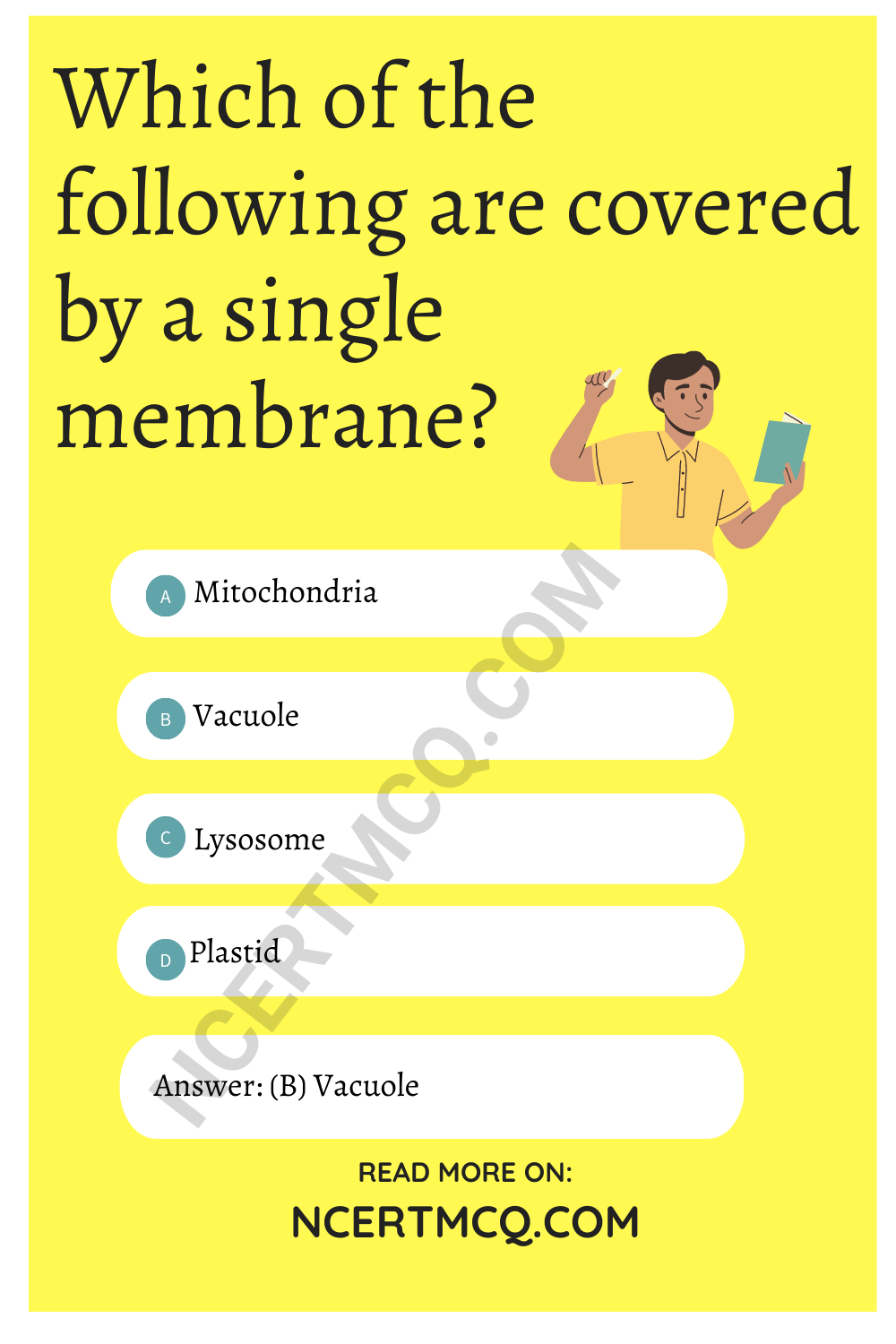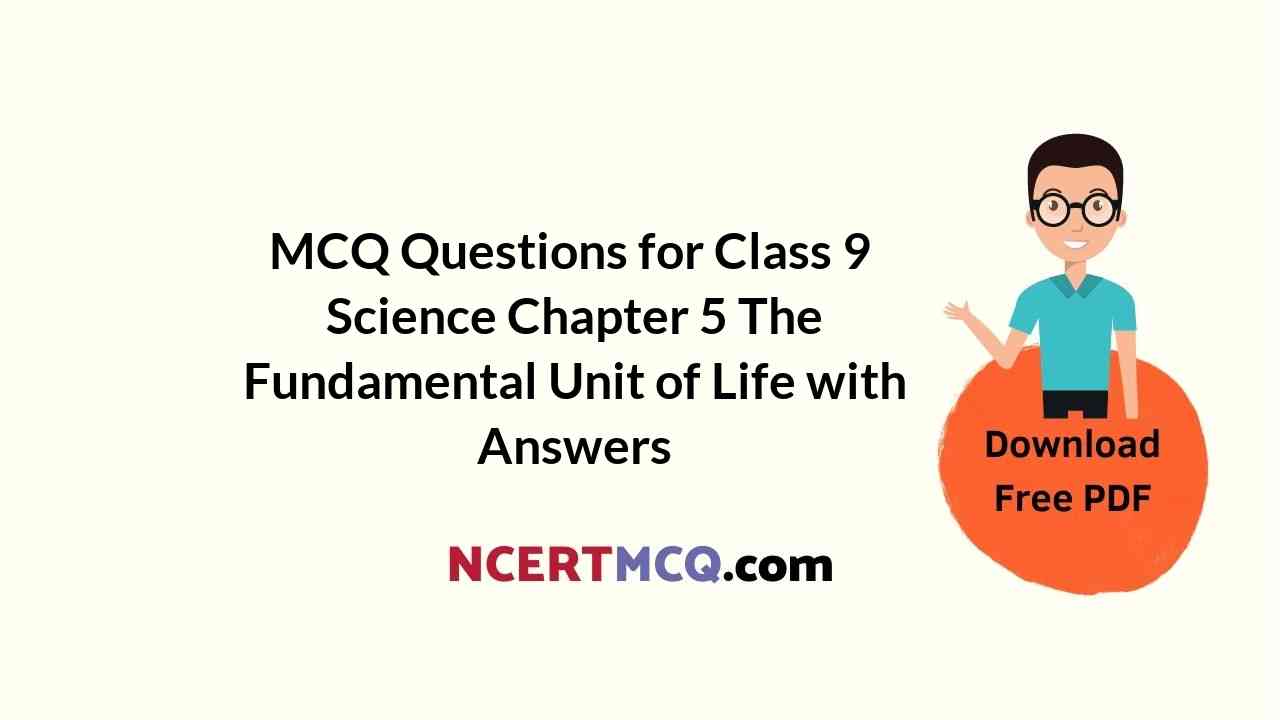Check the below Online Education NCERT MCQ Questions for Class 9 Science Chapter 5 The Fundamental Unit of Life with Answers Pdf free download. MCQ Questions for Class 9 Science with Answers were prepared based on the latest exam pattern. We have Provided The Fundamental Unit of Life Class 9 Science MCQs Questions with Answers to help students understand the concept very well. https://ncertmcq.com/mcq-questions-for-class-9-science-with-answers/
You can refer to NCERT Solutions for Class 9 Science Chapter 5 The Fundamental Unit of Life to revise the concepts in the syllabus effectively and improve your chances of securing high marks in your board exams.
Class 9 Science Biology Chapter 5 MCQ With Answers
Biology Class 9 Chapter 5 MCQs On The Fundamental Unit of Life
Fundamental Unit Of Life Class 9 MCQ Question 1.
Which of the following can be made into crystal?
(a) A bacterium
(b) An Amoeba
(c) A virus
(d) A sperm
Answer
Answer: (c) A virus
The Fundamental Unit Of Life Class 9 MCQ Question 2.
A cell will swell up if
(a) the concentration of water molecules in the cell is higher than the concentration of water molecules in the surrounding medium.
(b) the concentration of water molecules in the surrounding medium is higher than water molecules concentration in the cell.
(c) the concentration of water molecules is same in the cell and in the surrounding medium.
(d) concentration of water molecules does not matter.
Answer
Answer: (b) the concentration of water molecules in the surrounding medium is higher than water molecules concentration in the cell.
Class 9 Science Chapter 5 MCQ Question 3.
Chromosomes are made up of
(a) DNA
(b) Protein
(c) DNA and protein
(d) RNA
Answer
Answer: (c) DNA and protein
The Fundamental Unit Of Life MCQ Question 4.
Which of these options are not a function of ribosomes?
(i) It helps in manufacture of protein molecules.
(ii) It helps in manufacture of enzymes.
(iii) It helps in manufacture of hormones.
(iv) It helps in manufacture of starch molecules.
(a) (i) and (ii)
(b) (ii) and (iii)
(c) (iii) and (iv)
(d) (iv) and (i)
Answer
Answer: (c) (iii) and (iv)
The Fundamental Unit Of Life Class 9 MCQ With Answers Question 5.
Which of these is not related to endoplasmic reticulum?
(a) It behaves as a transport channel for proteins between nucleus and cytoplasm.
(b) It transports materials between various regions in the cytoplasm.
(c) It can be the site of energy generation.
(d) It can be the site for some biochemical activities of the cell.
Answer
Answer: (c) It can be the site of energy generation.
Ch 5 Science Class 9 MCQ Question 6.
Following are a few definitions of osmosis:
Read carefully and select the correct definition.
(a) Movement of water molecules from a region of higher concentration to a region of lower concentration through a semi-permeable membrane.
(b) Movement of solvent molecules from its higher concentration to lower concentration.
(c) Movement of solvent molecules from higher concentration to lower concentration of solution through a permeable membrane.
(d) Movement of solute molecules from lower concentration to higher concentration of solution through a semi permeable membrane.
Answer
Answer: (a) Movement of water molecules from a region of higher concentration to a region of lower concentration through a semi-permeable membrane.
Class 9 Science Ch 5 MCQ Question 7.
Plasmolysis in a plant cell is defined as
(a) breakdown (lysis) of plasma membrane in hypotonie medium
(b) shrinkageof cytoplasm in hypertonic medium
(c) shrinkage of nucleoplasm
(d) none of them
Answer
Answer: (b) shrinkageof cytoplasm in hypertonic medium
Class 9 Fundamental Unit Of Life MCQ Question 8.
Which of the following are covered by a single membrane?
(a) Mitochondria
(b) Vacuole
(c) Lysosome
(d) Plastid
Answer
Answer: (b) Vacuole

Chapter 5 Science Class 9 MCQ Question 9.
Find out the false sentence.
(a) Nucleus is involved with the formation of lysosomes.
(b) Nucleus, mitochondria and plastid have DNA, hence they are able to make their own structural proteins.
(c) Mitochondria is said to be the power house of the cell as ATP is generated in them.
(d) Cytoplasm is called as protoplasm.
Answer
Answer: (a) Nucleus is involved with the formation of lysosomes.
Class 9 Chapter 5 Science MCQ Question 10.
Find out the correct sentence.
(a) Enzymes packed in lysosomes are made through RER (rough endoplasmic reticulum).
(b) Rough endoplasmic reticulum and smooth endoplasmic reticulum produce lipid and protein respectively.
(c) Endoplasmic reticulum is rélated to the destruction of plasma membrane.
(d) Nucleoid is present inside the nucleoplasm of eukaryotic nucleus.
Answer
Answer: (a) Enzymes packed in lysosomes are made through RER (rough endoplasmic reticulum).
Class 9 Science Chapter 5 MCQ With Answers Question 11.
Which cell organelle plays a crucial role in detoxifring many poisons and drugs in a cell?
(a) Golgi apparatus
(b) Lysosomes
(c) Smooth endoplasmic reticulum
(d) Vacuoles
Answer
Answer: (c) Smooth endoplasmic reticulum
The Fundamental Unit Of Life Class 9 MCQ Questions Pdf Question 12.
The proteins and lipids, essential for building the cell membrane, are manufactured by
(a) rough endoplasmic reticulum
(b) golgi apparatus
(c) plasma membrane
(d) mitochondria
Answer
Answer: (a) rough endoplasmic reticulum
Class 9 Ch 5 Science MCQ Question 13.
The undefined nuclear region of prokaryotes is also known as
(a) nucleus
(b) nucleolus
(c) nucleic acid
(d) nucleoid
Answer
Answer: (d) nucleoid
MCQ Of Fundamental Unit Of Life Question 14.
The cell organelle involved in forming complex sugars from simple sugars are
(a) endoplasmic reticulum
(b) ribosomes
(c) plastids
(d) golgi apparatus
Answer
Answer: (d) golgi apparatus
Class 9 The Fundamental Unit Of Life MCQ Question 15.
Which out of the following is not a function of vacuole?
(a) Storage
(b) Providing turgidity and rigidity to the cell
(c) Waste excretion
(d) Locomotion
Answer
Answer: (d) Locomotion
Question 16.
Amoeba acquires its food through a process, termed
(a) exocytosis
(b) endocytosis
(c) plasmolysis
(d) exocytosis and endocytosis both
Answer
Answer: (b) endocytosis
Question 17.
Cell wall of which one of these is not made up of cellulose?
(a) Bacteria
(b) Hydrilla
(c) Mango tree
(d) Cactus
Answer
Answer: (a) Bacteria
Question 18.
Silver nitrate solution is used to study
(a) endoplasmic reticulum
(b) golgi apparatus
(c) nucleus
(d) mitochondria
Answer
Answer: (b) golgi apparatus
Question 19.
Organelle other than nucleus, containing DNA is
(a) endoplasmic reticulum
(b) golgi apparatus
(c) mitochondria
(d) lysosomes
Answer
Answer: (c) mitochondria
Question 20.
Kitchen of the cell is
(a) mitochondria
(b) endoplasmic reticulum
(c) chioroplast
(d) golgi apparatus
Answer
Answer: (c) chioroplast
Question 21.
Lipid molecules in the cell are synthesised by
(a) smooth endoplasmic reticulum
(b) rough endoplasmic reticulum
(c) golgi apparatus
(d) plastids
Answer
Answer: (a) smooth endoplasmic reticulum
Question 22.
Cell arises from pre-existing cell was stated by
(a) Haeckel
(b) Virchow
(c) Hooke
(d) Schleiden
Answer
Answer: (b) Virchow
Question 23.
Cell theory was given by
(a) Schleiden and Schwann
(b) Virchow
(c) Hooke
(d) Haeckel
Answer
Answer: (a) Schleiden and Schwann
Question 24.
The only cell organelle seen in prokaryotic cell is
(a) mitochondria
(b) ribosomes
(c) plastids
(d) lysosomes
Answer
Answer: (b) ribosomes
Question 25.
Organelle without a cell membrane is
(a) ribosome
(b) golgi apparatus
(c) chioroplast
(d) nucleus
Answer
Answer: (a) ribosome
Question 26.
1 μm is
(a) 10-6 m
(b) 10-9 m
(c) 10-10 m
(d) 10-3 m
Answer
Answer: (a) 10-6 m
Question 27.
Lysosome arises from
(a) endoplasmic reticulum
(b) golgi apparatus
(c) nucleus
(d) mitochondria
Answer
Answer: (b) golgi apparatus
Question 28.
Living cells were discovered by
(a) Robert Hooke
(b) Purkinje
(c) Leeuwenhoek
(d) Robert Brown
Answer
Answer: (c) Leeuwenhoek

Question 29.
Select the odd one out.
(a) The movement of water across a semi permeable membrane is affected by the amount of substances dissolved in it.
(b) Membranes are made of organic molecules like proteins and lipids.
(c) Molecules soluble in organic solvents can easily pass through the membrane.
(d) Plasma membranes contain chitin sugar in plants.
Answer
Answer: (d) Plasma membranes contain chitin sugar in plants.
Fill in the blanks.
1. …………… is a Latin word for ‘a little room’.
Answer
Answer: Cell
2. Plant cells are stained using the stain called …………….
Answer
Answer: safranin
3. Cells were first discovered by ……………. in 1665.
Answer
Answer: Robert Hooke
4. Leeuwenhoek (1674), with the improved microscope, discovered ………….. the in pond water for the first time.
Answer
Answer: free living cells
5. Virchow stated that ……………. arise from pre-existing cells.
Answer
Answer: all cells
6. The largest cell is …………….
Answer
Answer: ostrich egg
7. The …………. and …………… of cells are related to the specific function they perform.
Answer
Answer: shape; size
8. The process of …………… helps in movement of carbon dioxide or oxygen across the cell membrane.
Answer
Answer: diffusion
9. The movement of water molecules through a selectively permeable membrane is called …………….
Answer
Answer: osmosis
10. The …………… of the cell membrane enables the cell to engulf in food and other material from its external environment by process called endocytosis.
Answer
Answer: flexible nature
11. The chromatin material gets organised in the form of ………….. when the cell is about to divide.
Answer
Answer: chromosome
12. ………….. and …………. help in building the cell membrane by the process of membrane biogenesis.
Answer
Answer: Proteins; lipids
13. The hydrolytic enzymes present in the iysosomes are synthesised in the ………………
Answer
Answer: RER
14. Chromoplasts that contain …………… are called chioroplasts.
Answer
Answer: green coloured pigment
15. The primary function of leucoplasts is to ……………
Answer
Answer: store starch
Match the following columns
| Column A | Column B |
| (a) Vacuoles | (i) Store proteins |
| (b) Lysosomes | (ii) Shrinkage of cells |
| (c) Outer membrane of mitochondria | (iii) Detoxification of poison and drugs |
| (d) Elaioplasts | (iv) Turgidity of plant cell |
| (e) Aleuroplast | (v) Porous in nature |
| (f) Hypertonic solution | (vi) Scavengers of cell |
| (g) RER | (vii) Storage and modification |
| (h) SER | (viii) Store oils |
| (i) Golgi apparatus | (ix) Protein synthesis |
Answer
Answer:
| Column A | Column B |
| (a) Vacuoles | (iv) Turgidity of plant cell |
| (b) Lysosomes | (vi) Scavengers of cell |
| (c) Outer membrane of mitochondria | (v) Porous in nature |
| (d) Elaioplasts | (viii) Store oils |
| (e) Aleuroplast | (i) Store proteins |
| (f) Hypertonic solution | (ii) Shrinkage of cells |
| (g) RER | (ix) Protein synthesis |
| (h) SER | (iii) Detoxification of poison and drugs |
| (i) Golgi apparatus | (vii) Storage and modification |
We hope the given NCERT MCQ Questions for Class 9 Science Chapter 5 The Fundamental Unit of Life with Answers Pdf free download will help you. If you have any queries regarding The Fundamental Unit of Life CBSE Class 9 Science MCQs Multiple Choice Questions with Answers, drop a comment below and we will get back to you soon.
Class 9 Science Biology MCQ:
